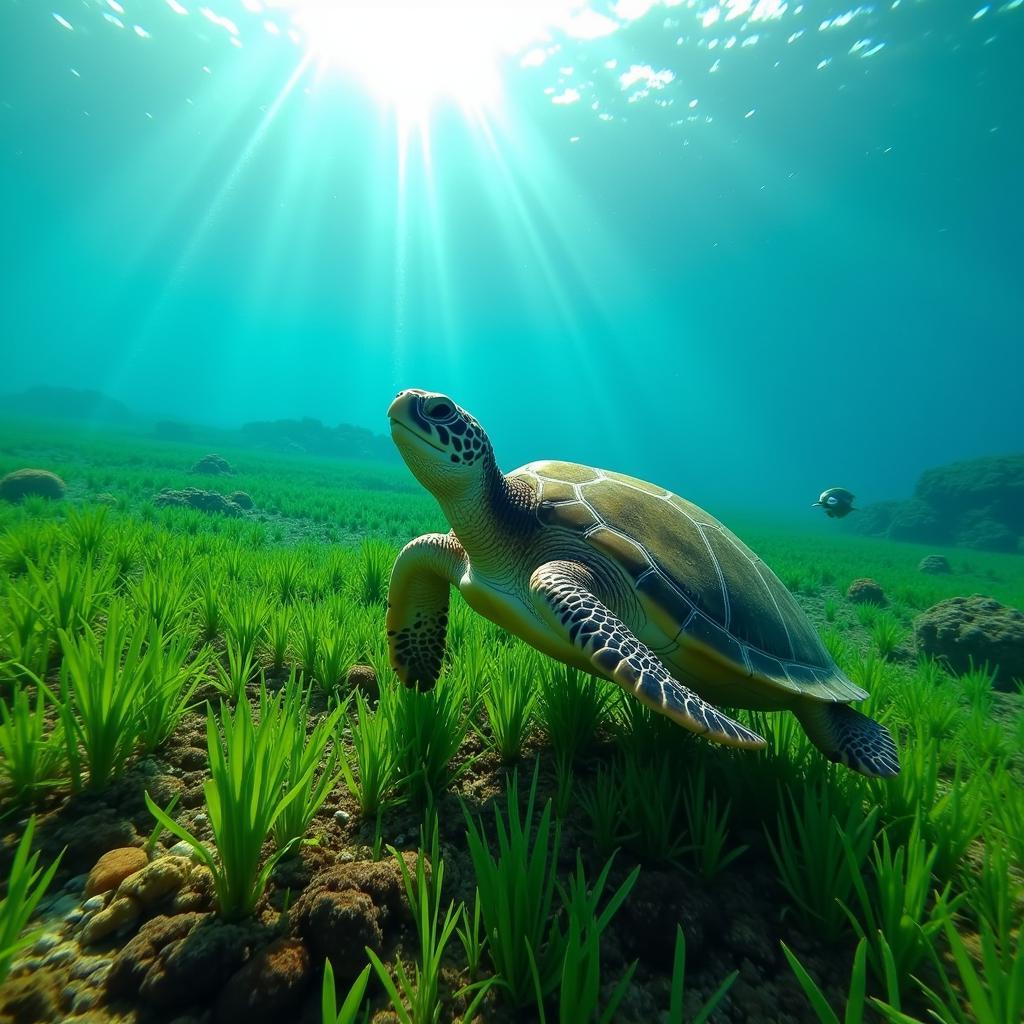The Food Web Of A Sea Turtle is a fascinating and complex system, crucial to the health of our oceans. These ancient mariners play a vital role in maintaining the balance of marine ecosystems, and understanding their dietary habits is key to their conservation. Let’s dive deep into the intricacies of what sea turtles eat and how they contribute to the delicate balance of life beneath the waves. If you’re curious about the food chain for sea turtles, this article will provide valuable insights.
What Do Sea Turtles Eat? A Deep Dive into Their Diet
Sea turtles, depending on the species, can be herbivores, carnivores, or omnivores. Their diets vary considerably, influenced by factors like their age, species, and the specific habitat they inhabit. For instance, green sea turtles are primarily herbivorous as adults, grazing on seagrass and algae. This grazing helps maintain healthy seagrass beds, which are vital nurseries for many other marine species. Loggerheads, on the other hand, are carnivorous, preferring to feast on crabs, conchs, and jellyfish.
The Importance of Seagrass in the Green Sea Turtle’s Diet
Seagrass meadows are not just a food source for green sea turtles; they are essential habitats that provide shelter and breeding grounds for countless marine organisms. By consuming seagrass, green sea turtles help to keep these meadows healthy and thriving. This contributes to the overall biodiversity of the ocean.
 Green Sea Turtle Grazing on Seagrass in a Tropical Ocean
Green Sea Turtle Grazing on Seagrass in a Tropical Ocean
Hawksbill turtles have a more specialized diet, focusing primarily on sponges. Their beak-like mouths are perfectly adapted for reaching into crevices and extracting these invertebrates. This selective feeding behavior influences the distribution and abundance of sponge populations on coral reefs. Leatherback turtles, the largest of all sea turtle species, feed mainly on jellyfish. This dietary preference plays a significant role in controlling jellyfish populations, which can sometimes explode and disrupt the balance of marine ecosystems.
The Food Web Connections: Predators and Prey
Sea turtle hatchlings are particularly vulnerable to predation. Birds, crabs, and even fish prey on these tiny creatures as they make their perilous journey from nest to ocean. As sea turtles grow, their size and tough shells offer some protection, but they still face threats from larger predators like sharks, orcas, and crocodiles.
How Sea Turtles Impact Their Environment Through Their Diet
The food web of a sea turtle is not a one-way street. While they consume various organisms, they also contribute to the ecosystem in significant ways. Their grazing habits, for example, can shape the structure of seagrass beds and influence the distribution of other species. Their excrement provides nutrients for the ocean floor, supporting a variety of bottom-dwelling organisms. What are some resources on turtle island food truck?
 Sea Turtle Food Web Diagram Illustrating Predators and Prey
Sea Turtle Food Web Diagram Illustrating Predators and Prey
Human Impacts on the Sea Turtle Food Web
Human activities, unfortunately, pose significant threats to the delicate balance of the sea turtle food web. Pollution, habitat destruction, and fishing gear entanglement are just some of the challenges these creatures face. Plastic pollution, in particular, is a growing concern, as sea turtles often mistake plastic bags for jellyfish, leading to ingestion and potentially fatal consequences. Climate change also impacts the food web by altering ocean temperatures and affecting the distribution and abundance of prey species. Looking for unique food shaped bags?
Conservation Efforts to Protect Sea Turtles and Their Food Web
Numerous organizations and initiatives are working tirelessly to protect sea turtles and their vital role in the marine ecosystem. These efforts include protecting nesting sites, reducing plastic pollution, and promoting sustainable fishing practices. Public awareness and education are also crucial components of these conservation strategies, empowering individuals to make informed choices that benefit sea turtles and the health of our oceans. Considering food truck catering long island?
Conclusion
The food web of a sea turtle is a complex tapestry of interconnected relationships, vital to the health and balance of our oceans. Understanding the intricate workings of this web is crucial for effective conservation efforts. By protecting sea turtles and their habitats, we are not only safeguarding these incredible creatures but also ensuring the long-term health and resilience of our planet’s marine ecosystems. The food web of a sea turtle is a reminder of the delicate balance of nature and the importance of our role in its preservation.
FAQ
- What is the primary food source for green sea turtles? Seagrass and algae.
- What do loggerhead sea turtles eat? Primarily crabs, conchs, and jellyfish.
- What is the biggest threat to sea turtle hatchlings? Predation by birds, crabs, and fish.
- How does plastic pollution affect sea turtles? They often mistake plastic bags for jellyfish and ingest them.
- What are some ways to help protect sea turtles? Reduce plastic consumption, support sustainable fishing practices, and participate in beach cleanups.
- What is the role of hawksbill turtles in the food web? They primarily consume sponges, influencing sponge populations on coral reefs.
- How does climate change affect the sea turtle food web? It alters ocean temperatures and impacts the distribution and abundance of prey species.
Have you ever wondered about turtle sticks food?
Need help? Contact us 24/7! Phone: 02437655121, Email: minacones@gmail.com, Address: 3PGH+8R9, ĐT70A, thôn Trung, Bắc Từ Liêm, Hà Nội, Việt Nam.